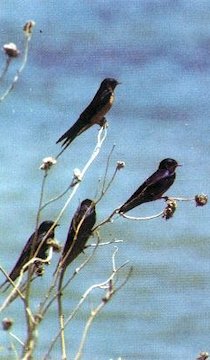
|
Birds Checking the Weather
Just as long-term changes in climate have molded the evolution of bird migration, seasonal and day-to-day changes in weather dramatically influence the timing and course of migration. When the weather conditions are right, the number of birds in flight can reach millions. Not only are the immediate flight conditions important, but the weather at the destination or starting point of the flight may also be critical to a bird's survival. For example, water birds must not arrive at northern latitudes before the ice has melted, and many tend to follow the spring thaw northward; in late fall many linger in the north until freezing temperatures force them to move. For most birds, however, it pays to anticipate seasonal changes in climate and to be gone well before conditions deteriorate. Many warblers, flycatchers, and other insect eaters begin their fall migration in late summer while the days are still warm and the insect life abundant. During migration, the most critical weather factors are wind direction and changes in temperature. In spring, northbound birds select the warming temperatures and southerly winds that characterize the western side of high-pressure systems; in fall, they favor the lower temperatures and north winds that occur following the passage of a cold front. Birds also tend to avoid rainy, overcast weather, fog, and high winds, and even stop in the middle of their journey if they encounter deteriorating weather while over land. Recent research has shown that pigeons are quite sensitive to small changes in air pressure, birds are able to anticipate weather before any overt signs are evident. Insect-eaters like the Barn Swallow begin to migrate in late summer, well before their food supply is threatened by early frosts. Spring migrants, driven to reach the breeding grounds early, are often caught by late spring storms that cause high mortality. Return to Bird Migration and Navigation |
| Barn Swallows |